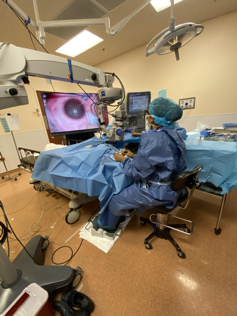Common infections like cold sores, chickenpox and shingles may incite a quiet, but serious condition that many Americans do not even know they have — eye inflammation. The ocular condition, medically referred to as uveitis or scleritis depending on which part of the eye is affected, can lead to poor vision or even blindness.

Data indicates that ocular inflammation attributes to 15 percent of blindness in the U.S., and many Americans are unknowingly living with this potentially grave eye issue. That’s why Dr. Sarina Amin, a top doctor at Magruder Eye Institute in Orlando, Fla., is studying the prevalence of infectious uveitis and scleritis across the U.S. She published an article on this topic in coordination with a team of research ophthalmologists at the University of Southern California’s Roski Eye Institute.
“If people realized the correlation of systematic disease and ocular inflammation, I think more people would get their eyes checked regularly,” Amin said.
Uveitis is inflammation of the uvea, the middle layer of the eye including the iris, lens or retina. Scleritis is an inflammation of the sclera, or white part of the eye. Two unique conditions can cause eye inflammation: systemic inflammatory/autoimmune disease and infection. Amin and the research team looked solely at infectious uveitis and scleritis, or ocular inflammation cause by infection.
“Infectious uveitis and scleritis requires treatment of the infection with antibiotics or antivirals, while noninfectious uveitis and scleritis requires immunosuppressive therapies. Immunosuppressive therapies, if given to an infectious uveitis and scleritis patient, can actually worsen the inflammation,” Amin noted.
Dr. Amin and the team determined that many more Americans have infectious uveitis or scleritis than previously reported. To put it into perspective, previous studies suggested that 12 in 100,000 people have uveitis or scleritis, where in all actuality, 60 in 100,000 people have it.
“This suggests that prior studies significantly underestimated the prevalence of infectious uveitis in the U.S. population,” Amin said.
Not only can ocular inflammation lead to blindness, it presents a $242 million economic impact nationwide each year. The hefty bill can be attributed to frequent doctor visits as the condition leads patients to ophthalmology, rheumatology, primary care and other specialists. The cost of drugs to treat the conditions is costly. Patients with eye inflammation have reduced productivity in the workforce, in addition to their caregiver’s productivity as many patients lose their ability to drive and need transportation to and from multiple appointments).
“We are conducting further research on the demographics of non-infectious uveitis patients to help determine the overall cost of uveitis-related healthcare,” Amin noted. “We must understand its prevalence and devise a plan to treat those who are impacted to reduce vision loss and lessen the economic impact.”
As if taking on this worldly challenge is not heroic enough, Dr. Amin is also studying the efficacy of injectable medications, namely aflibercept, given to premature newborns shortly after birth to prevent blindness, in which 20,000 babies are born at risk per year. The published paper can be read online at this link.
If saving the world’s eyes from birth to adulthood wasn’t enough, Dr. Amin is a retina surgeon, treating about 60 patients on any given day at Magruder Eye Institute. A clear example that not all heroes wear capes, Dr. Amin sports surgical scrubs, a high-tech microscope and intelligence that rivals the brightest to save the world, one set of eyes at a time.









